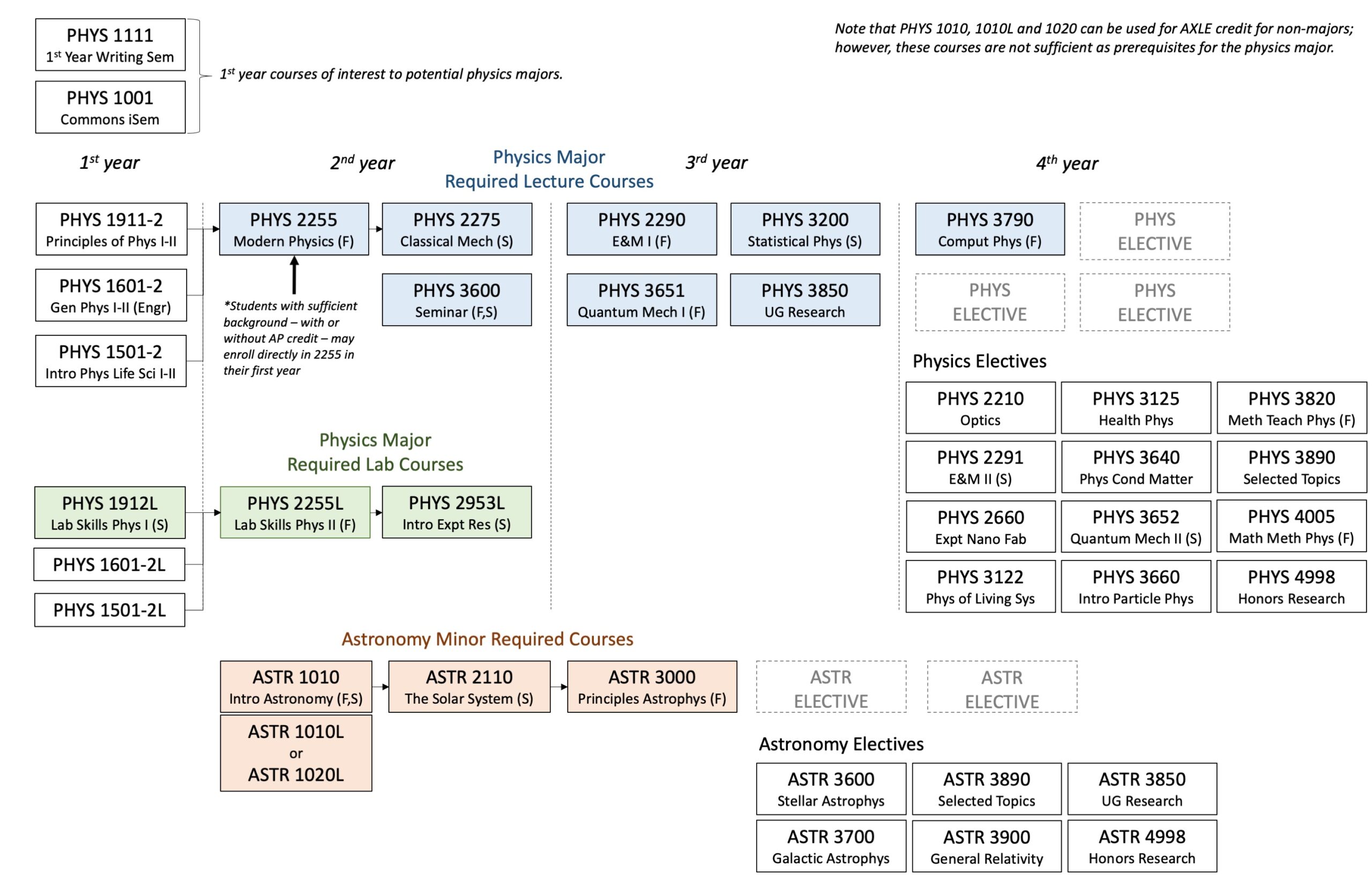Courses
Core Courses
PHYS 1501 and 1502: The 1501/1502 sequence is a calculus-based introduction to physics taught within the context of life science applications. Students enroll separately in the accompanying laboratory classes (1601L/1602L).
PHYS 1601 and 1602: The 1601/1602 sequence is a calculus-based introduction to general physics and its applications intended for students in the natural sciences and engineering. Students enroll separately in the accompanying laboratory classes (1601L/1602L).
PHYS 1911 and 1912: The 1911/1912 sequence is an intensive, calculus-based introduction to general physics and its applications intended for students planning to major in physics. Students taking 1911 (Fall semester, only) should plan to take the first-semester lab (1912L) in the Spring semester. Students taking 1912 (Spring semester, only) should plan to take the second-semester lab (2255L) in the third semester (Fall). Physics majors will then take a third semester lab (2953L) in the fourth semester.
Regarding calculus and the 1911/1912 sequence: Students who studied calculus in high school but who did not receive AP credit for Calculus from Vanderbilt may still take 1911 with permission of the Director of Undergraduate Studies of Physics and Astronomy. Students in this situation could consult with the DUS to determine whether they have a strong enough mathematical background to take these courses. Note, however, that 1912 assumes students are taking multi-variable calculus (MATH 2300), so a student who begins in 1911 and in MATH 1300 probably should then take 1602 in the Spring, along with MATH 1301. This student can then continue in the third semester with PHYS 2255 and MATH 2300.
PHYS 1010/1020: PHYS 1010 is a one-semester, algebra-based introductory physics course designed for non-science majors. It is not adequate as preparation for any of the pre-health professions (medical, dental, physical therapy). Vanderbilt students seeking a full year of algebra-trigonometry-based physics as preparation for a career in one of the health professions will need to take that coursework in the summer at another university.
PHYS 2051 and 2053: Students who take a rigorous algebra-trigonometry-based physics sequence may transfer those credits to Vanderbilt. The first semester (PHYS 2051) of such a sequence should cover the topical areas of mechanics, heat, and sound. The second semester (PHYS 2053) of such a sequence should cover the topical areas of electricity & magnetism optics, and modern physics. The first semester lab would transfer as PHYS 2052 and the second semester lab would transfer as PHYS 2054. Note: these courses (2051, 2052, 2053, 2054) are not taught at Vanderbilt. These course numbers are used only for transfer credit for the coursework as described herein.
ASTR 1010: Observed and physical properties of stars. Supernovae, neutron stars, and black holes. Our Milky Way galaxy and other galaxies. Cosmology, dark matter, dark energy, and the Big Bang. Students enroll separately in the accompanying laboratory classes (1010L/1020L).
PHYS-2275: Classical Mechanics
Calculus of variations. Lagrangian and Hamiltonian dynamics. Conservation laws. Vector algebra and coordinate transformations. Gravity and potential energy. Free, forced, damped, and nonlinear harmonic oscillations. The anharmonic oscillator and chaos. Orbital and rotational angular momentum. Gravitational and Coulomb central-force problems. Motion in non-inertial reference frames. Coupled oscillators and normal modes. Rigid-body motion. Continuous systems and the wave equation.
PHYS-3200/5200: Statistical Physics
Temperature, work, heat, and the first law of thermodynamics. Entropy and the second law of thermodynamics. Kinetic theory of gases with applications to ideal gases and electromagnetic radiation.
PHYS-3290/5290: Electricity, Magnetism, and Electrodynamics I
Electrostatic fields and potentials. Gauss's law. Electrical properties of insulators, semiconductors, and metals. The Lorentz force. Magnetic fields and forces. Electromagnetic induction, Maxwell's equations, and electromagnetic waves
PHYS-3651/5651: Advanced Quantum Mechanics I
Wave-particle duality, indeterminacy, superposition, the Schrödinger equation, angular momentum, the hydrogen atom, and spin and indistinguishability
PHYS-3660: Introduction to Particle Physics
Weak, strong, and electromagnetic forces as evidenced by the interactions of elementary particles. Classification of particles and experimental techniques. Corequisite: 2255 or 3651.
PHYS-3790: Computational Physics
Topics in modern physics analyzed exclusively with computer programs. Finite difference approaches to the Schrödinger and Maxwell equations. Solutions of nonlinear equations. Molecular dynamics. Monte Carlo simulations. Growth models and random walks.
PHYS-4005: Mathematical Methods for Physicists
Linear spaces and operators; matrix algebra; differential equations; Green's function; and complex analysis. Variational calculus; perturbation methods; group theory. Prerequisite: 2275, 2290; and one of MATH 2400, 2420, or 2610.
PHYS-2210/5210: Classical and Modern Optics
Geometrical optics, including reflection, refraction, ray tracing, aberrations, and interference. Physical optics, including wave theory, absorption, dispersion, diffraction, and polarization. Properties of light from lasers and synchrotron sources. Photodetectors and optical technology.
PHYS-3652: Quantum Mechanics II
Time-independent and time-dependent perturbation theory, matrix theory, scattering, applications to atomic physics, condensed matter physics, and astrophysics. Prerequisite: 2290 and 3651.
ASTR-2110: The Solar System
The sky, orbits, and gravity. Ancient astronomy. Seasons, the calendar, phases and motions of the moon, tides, and eclipses. Terrestrial planets, giant planets and their moons and rings, asteroids, comets, meteorites, and the sun. Habitable zones for planets and moons, extremophiles, and the possibility of life on other worlds.
ASTR-3000: Principles of Astrophysics
Tools and methods of astrophysics, including light and telescopes. Cosmology, the Big Bang, and the origin and evolution of matter. Galaxies, star formation, and the physics of stars, including nucleosynthesis and stellar death. Techniques for discovering and measuring properties of exoplanets. Prerequisite: either PHYS 1501, 1601, or 1911: and either MATH 1100, 1200, or 1300.
Timetable of Coursework

Download PDF version here.
